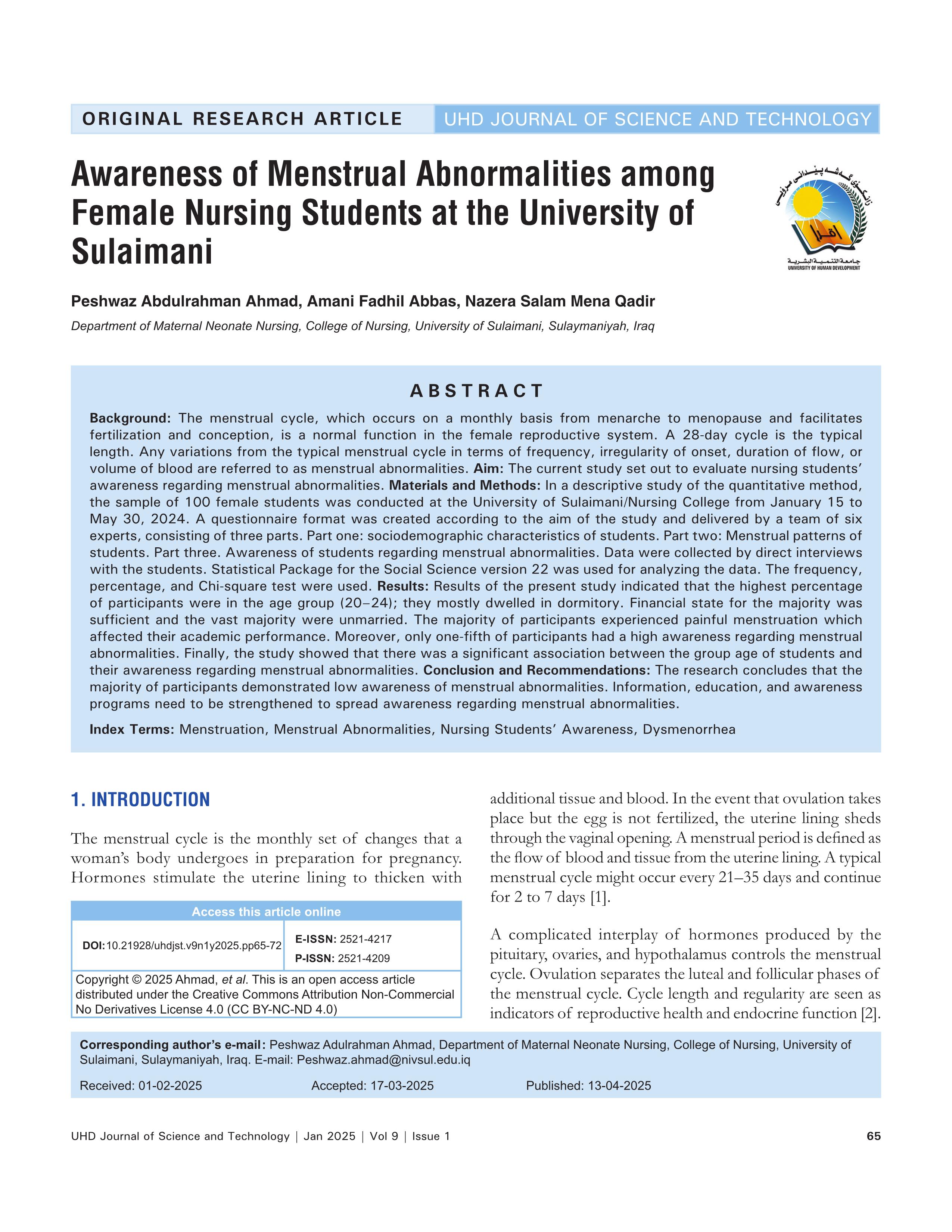Awareness of Menstrual Abnormalities among Female Nursing Students at the University of Sulaimani
DOI:
https://doi.org/10.21928/uhdjst.v9n1y2025.pp65-72Keywords:
Menstruation, Menstrual Abnormalities, Nursing Students’ Awareness, DysmenorrheaAbstract
Background: The menstrual cycle, which occurs on a monthly basis from menarche to menopause and facilitates fertilization and conception, is a normal function in the female reproductive system. A 28-day cycle is the typical length. Any variations from the typical menstrual cycle in terms of frequency, irregularity of onset, duration of flow, or volume of blood are referred to as menstrual abnormalities. Aim: The current study set out to evaluate nursing students’ awareness regarding menstrual abnormalities. Materials and Methods: In a descriptive study of the quantitative method, the sample of 100 female students was conducted at the University of Sulaimani/Nursing College from January 15 to May 30, 2024. A questionnaire format was created according to the aim of the study and delivered by a team of six experts, consisting of three parts. Part one: sociodemographic characteristics of students. Part two: Menstrual patterns of students. Part three. Awareness of students regarding menstrual abnormalities. Data were collected by direct interviews with the students. Statistical Package for the Social Science version 22 was used for analyzing the data. The frequency, percentage, and Chi-square test were used. Results: Results of the present study indicated that the highest percentage of participants were in the age group (20–24); they mostly dwelled in dormitory. Financial state for the majority was sufficient and the vast majority were unmarried. The majority of participants experienced painful menstruation which affected their academic performance. Moreover, only one-fifth of participants had a high awareness regarding menstrual abnormalities. Finally, the study showed that there was a significant association between the group age of students and their awareness regarding menstrual abnormalities. Conclusion and Recommendations: The research concludes that the majority of participants demonstrated low awareness of menstrual abnormalities. Information, education, and awareness programs need to be strengthened to spread awareness regarding menstrual abnormalities.
References
G. M. Attia, O. A. Alharbi and R. M. Aljohani RM, “The Impact of irregular menstruation on health: A review of the literature,” Cureus, vol. 15, no. 11, p. e49146, 2023.
S. Song, H. Choi, Y. Pang, O. Kim and H. Y. Park, “Factors associated with regularity and length of menstrual cycle: Korea Nurses’ Health Study,” BMC Womens Health, vol. 22, p. 361, 2022.
D. K. Thiyagarajan, H. Basit and R. Jeanmonod, “Physiology, Menstrual Cycle,” Statpearls Publishing, Treasure Island, FL, 2022.
A. Jadwat and U. B. Bassa and Anastachia Rungusumy and Mahesh Shumsher Rughooputh, “Level of awareness on menstrual health among university students in Mauritius,” Womens Health and Wellness, vol. 7, p. 122, 2021.
Z. Bumbuliene, D. Sragyte, J. Klimasenko and E. Bumbul-Mazurek, “Abnormal uterine bleeding in adolescents: Ultrasound evaluation of uterine volume,” Gynecological Endocrinology, vol. 35, no. 4, pp. 356-359, 2019.
M. H. Alhammadi, A. M. Albogmi, M. K. Alzahrani, B. H. Shalabi, F. A. Fatta and S. F. AlBasri, “Menstrual cycle irregularity during examination among female medical students at King Abdulaziz University, Jeddah, Saudi Arabia,” BMC Womens Health, vol. 22, no. 1, p. 367, 2022.
S. Chauhan, P. Kumar, R. Patel, S. Srivastava, D. J. Simon and T. Mohammad, “Association of lifestyle factors with menstrual problems and its treatment-seeking behavior among adolescent girls,” Clinical Epidemiology and Global Health, vol. 12, p. 100905, 2021.
N. Manna, A. S. Jainendran, S. Mondal and S. Das, “A study on menstrual abnormalities among undergraduate students of medical college, Kolkata,” National Journal of Physiology, Pharmacy and Pharmacology, vol. 13, no. 6, pp. 1246-1252, 2023.
S. Shrestha, S. Manandhar, C. Limbu, C. Kunwar, P. Sinha and R. Shrestha, “Menstrual disorders and its effects on academic performance among the nursing students of PUSHS, Gothgaun,” Birat Journal of Health Sciences, vol. 7, no. 3, p. 1871-1876, 2022.
V. Kanti, V. Verma and N. P. Singh, “Study of menstrual abnormalities and its association with demographic factors among female medical students,” Journal of Clinical And Diagnostic Research, vol. 40, pp. QC06-QC09, 2020.
F. Bahadori, Z. Sahebazzamani, S. Ghasemzadeh, Z. Kousehlou, L. Zarei, M. Hoseinpour, “Menstrual Cycle disorders and their relationship with body mass index (BMI) in adolescent girls,” Journal of Obstetrics, Gynecology and Cancer Research, vol. 8, no. 4, pp. 327-334, 2023.
O. Esimai and G. Esan, “Awareness of menstrual abnormality amongst college students in urban area of Ile-Ife, Osun State, Nigeria,” Indian Journal of Community Medicine, vol. 35, no. 1, p. 63, 2010.
F. L. Cousins and P. T. K. Saunders, “Editorial: Menstruation: Myths, mechanisms, models and malfunctions,” Frontiers in Reproductive Health, vol. 5, pp. 1-3, 2023.
L. Tiranini and R. E. Nappi, “Recent advances in understanding/ management of premenstrual dysphoric disorder/premenstrual syndrome,” Faculty Reviews, vol. 11, p. 11, 2022.
H. K. Al-Qazaz and R. O. Al-Dabbagh, “Menstrual disorder: Cross-sectional study on prevalence and self-care practice among adolescents in Iraq,” Annals of Tropical Medicine and Public Health, vol. 23, no. 4, pp. 125-132, 2020.
U. C. Igbokwe and Y. O. John-Akinola, “Knowledge of menstrual disorders and health seeking behaviour among female undergraduate students of University of Ibadan, Nigeria,” Annals of Ibadan Postgraduate Medicine, vol. 19, no. 1, pp. 40-48, 2021.

Downloads
Published
How to Cite
Issue
Section
License
Copyright (c) 2025 Peshwaz Abdulrahman Ahmad, Amani Fadhil Abbas, Nazera Salam Mena Qadir

This work is licensed under a Creative Commons Attribution-NonCommercial-NoDerivatives 4.0 International License.


